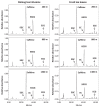Catechin content and the degree of its galloylation in oolong tea are inversely correlated with cultivation altitude
- PMID: 28911419
- PMCID: PMC9354868
- DOI: 10.1016/j.jfda.2013.12.001
Catechin content and the degree of its galloylation in oolong tea are inversely correlated with cultivation altitude
Abstract
The taste quality of oolong tea generated from leaves of Camellia sinensis L. cultivated in the same mountain area is positively correlated to the cultivation altitude, partly due to the inverse correlation with the astringency of the tea infusion. The astringency of oolong tea mostly results from the presence of polyphenolic compounds, mainly catechins and their derivatives. Four catechins, (-)-epicatechin (EC) and (-)-epigallocatechin (EGC) together with their gallate derivatives (with relatively high astringency), (-)-EC gallate (ECG) and (-)-EGC gallate (EGCG), were detected as major compounds in oolong tea. The degrees of catechin galloylation, designated as ECG/(EC + ECG) and EGCG/(EGC + EGCG), in both oolong tea infusions and their fresh tea leaves, were found to be inversely correlated to the cultivation altitude at 200 m, 800 m, and 1300 m. A similar inverse correlation was observed when seven more oolong tea infusions and seven more fresh leaves harvested at altitude ranging from 170 m to 1600 m were recruited for the analyses. Moreover, catechin contents in oolong tea infusions were also found to be inversely correlated to the cultivation altitude. It is proposed that catechin content and the degree of its galloylation account for, at least partly, the inverse correlation between the astringency of oolong tea and the cultivation altitude.
Keywords: Astringency; Catechin; Cultivation altitude; Galloylation; Oolong tea.
Copyright © 2014. Published by Elsevier B.V.
Conflict of interest statement
All authors declare no conflicts of interest.
Figures




References
-
- Yukihiko H. Elucidation of physiological functions of tea catechins and their practical applications. J Food Drug Anal. 2012;20:296–300.
-
- Chung SY, Huanyu J, Fei G, et al. Cancer preventive activities of tea polyphenols. J Food Drug Anal. 2012;20:318–22.
-
- Tsutomu N, Takeshi I, Yoshinori U, et al. Interaction of tea catechins with phospholipids – roles in their tastes and biological activities. J Food Drug Anal. 2012;20:305–8.
-
- Higdon JV, Frei B. Tea catechins and polyphenols: health effects, metabolism, and antioxidant functions. Crit Rev Food Sci Nutr. 2003;43:89–143. - PubMed
-
- Lee VSY, Dou J, Chen RJY, et al. Massive accumulation of gallic acid and unique occurrence of myricetin, quercetin and kaempferol in preparing old oolong tea. J Agric Food Chem. 2008;56:7950–6. - PubMed
LinkOut - more resources
Full Text Sources
Other Literature Sources
